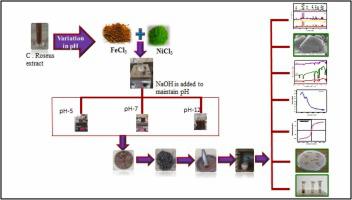当前位置:
X-MOL 学术
›
Nano-Struct. Nano-Objects
›
论文详情
Our official English website, www.x-mol.net, welcomes your feedback! (Note: you will need to create a separate account there.)
Influence of pH on structural, optical and magnetic properties of undoped and Ni-doped α-Fe2O3 nanoparticles for antimicrobial activity
Nano-Structures & Nano-Objects Pub Date : 2024-01-31 , DOI: 10.1016/j.nanoso.2024.101098 N. Pavithra , M. Nirmala , S. Priyadharshini , U. Kavitha , B. Kavitha
Nano-Structures & Nano-Objects Pub Date : 2024-01-31 , DOI: 10.1016/j.nanoso.2024.101098 N. Pavithra , M. Nirmala , S. Priyadharshini , U. Kavitha , B. Kavitha

|
In this present study, the magnetic and antimicrobial properties of biosynthesized α-FeO and Ni doped α-FeO nanoparticles were synthesized from ferric chloride and nickel chloride with the addition of Catharanthus roseus flower extract for different sodium hydroxide concentrations to maintain the pH as 5, 7 and 12. The influence of pH indicates changes observed in the size, structure and crystallinity of the prepared samples. The synthesized nanoparticles were characterized by X-ray diffraction (XRD), field emission scanning electron microscopy (FESEM), energy dispersive spectroscopy (EDS), Fourier transform infrared spectroscopy (FTIR), UV visible spectroscopy (UV-Vis) and vibrating sample magnetometry (VSM), and their antimicrobial and antioxidant properties were investigated. The XRD analysis revealed the prepared nanoparticles have a rhombohedral hematite structure. FTIR analysis in the range 4000 to 400 cm confirmed the presence of various functional groups for the prepared nanoparticles. The surface morphology and as well as structures of the prepared nanoparticles were confirmed by FESEM. The UV–Vis analysis showed the band gap energies of undoped and Ni-doped α-FeO nanoparticles Furthermore, the VSM analysis showed the magnetic properties of undoped and Ni-doped α-FeO nanoparticles, exhibiting ferromagnetic behaviour at room temperature. The total reducing power of the as-prepared Ni doped α-FeO nanoparticles was maximum for pH 7, while the antioxidant property was lowered for the remaining samples.The inhibition zone of the prepared nanoparticles showed good antimicrobial activity for pH 7 and showed less inhibition for the other samples against Escherichia coli and Staphylococcus aureus.
中文翻译:

pH 对未掺杂和 Ni 掺杂 α-Fe2O3 纳米颗粒抗菌活性的结构、光学和磁性的影响
在本研究中,生物合成的 α-FeO 和 Ni 掺杂的 α-FeO 纳米颗粒的磁性和抗菌特性是由氯化铁和氯化镍合成的,并添加长春花提取物,以不同的氢氧化钠浓度保持 pH 为 5, 7 和 12。pH 的影响表明所观察到的所制备样品的尺寸、结构和结晶度的变化。通过X射线衍射(XRD)、场发射扫描电子显微镜(FESEM)、能量色散光谱(EDS)、傅里叶变换红外光谱(FTIR)、紫外可见光谱(UV-Vis)和振动样品磁强计对合成的纳米粒子进行了表征(VSM),并研究了它们的抗菌和抗氧化特性。XRD分析表明所制备的纳米粒子具有菱面体赤铁矿结构。4000 至 400 cm 范围内的 FTIR 分析证实了所制备的纳米颗粒存在各种官能团。通过FESEM 证实了所制备纳米粒子的表面形貌和结构。UV-Vis 分析显示了未掺杂和 Ni 掺杂 α-FeO 纳米粒子的带隙能量。此外,VSM 分析显示了未掺杂和 Ni 掺杂 α-FeO 纳米粒子的磁性,在室温下表现出铁磁行为。所制备的 Ni 掺杂 α-FeO 纳米颗粒的总还原力在 pH 7 时最大,而其余样品的抗氧化性能较低。制备的纳米颗粒的抑菌圈在 pH 7 时表现出良好的抗菌活性,且抑制较小用于抗大肠杆菌和金黄色葡萄球菌的其他样品。
更新日期:2024-01-31
中文翻译:

pH 对未掺杂和 Ni 掺杂 α-Fe2O3 纳米颗粒抗菌活性的结构、光学和磁性的影响
在本研究中,生物合成的 α-FeO 和 Ni 掺杂的 α-FeO 纳米颗粒的磁性和抗菌特性是由氯化铁和氯化镍合成的,并添加长春花提取物,以不同的氢氧化钠浓度保持 pH 为 5, 7 和 12。pH 的影响表明所观察到的所制备样品的尺寸、结构和结晶度的变化。通过X射线衍射(XRD)、场发射扫描电子显微镜(FESEM)、能量色散光谱(EDS)、傅里叶变换红外光谱(FTIR)、紫外可见光谱(UV-Vis)和振动样品磁强计对合成的纳米粒子进行了表征(VSM),并研究了它们的抗菌和抗氧化特性。XRD分析表明所制备的纳米粒子具有菱面体赤铁矿结构。4000 至 400 cm 范围内的 FTIR 分析证实了所制备的纳米颗粒存在各种官能团。通过FESEM 证实了所制备纳米粒子的表面形貌和结构。UV-Vis 分析显示了未掺杂和 Ni 掺杂 α-FeO 纳米粒子的带隙能量。此外,VSM 分析显示了未掺杂和 Ni 掺杂 α-FeO 纳米粒子的磁性,在室温下表现出铁磁行为。所制备的 Ni 掺杂 α-FeO 纳米颗粒的总还原力在 pH 7 时最大,而其余样品的抗氧化性能较低。制备的纳米颗粒的抑菌圈在 pH 7 时表现出良好的抗菌活性,且抑制较小用于抗大肠杆菌和金黄色葡萄球菌的其他样品。



























 京公网安备 11010802027423号
京公网安备 11010802027423号